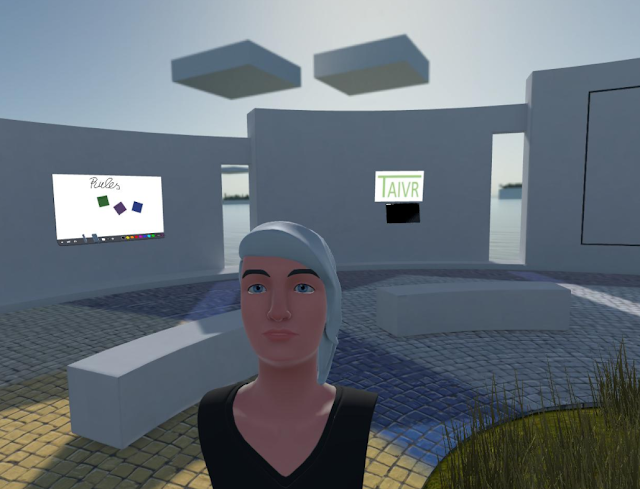Best Practices to set up workshops in Virtual Reality
The following best practices assume that the VR Collaboration platform and hardware is already selected.
1) Onboard new users
To meet in Virtual Reality is a brand-new and uncommon way of communication. Before calling into the VR Room - make sure all participants know what to expect and have at least experienced the VR Room once before. Ideally, all users have pre-set devices in their hands. Upfront of the first VR workshop, invite new users e.g. personally or into a simple video conference to explain: purpose of VR collaboration, known advantages and limits, basic usage of the headset, basic usage of the tool, ideal surrounding / space. Jointly enter the VR Room then and guide with simple instructions to use mandatory functions like moving around, writing, sticky notes or switching rooms (whatever is used in your later workshop)
Photo taken in GLUE / Lake Cubic space
2) Define meeting / workshop rules
Just as EVERY other form of meeting or workshop, define rules which every participant consents on. There is plenty of resources to check general ground rules for real life workshops which are helpful in VR as well. Adapt those to your organisation - and to the setting in virtual reality. While VR spatial audio fosters the communication and the experience is way more immersive and less distractive, additional simple rules should be agreed e.g. regular breaks, movements within the virtual space, reaction to technical issues.
3) Have a host experienced in VR
Meetings and even more workshops run way more effective with an experienced facilitator. Many dynamics of real-life workshops are vivid in VR as well. That is the easy part. Beside, changes in behavior occur for individuals e.g. either to extroverts who struggle with the technology or introverts who finally feel more safe talking. A perfect host knows the participants, senses those hurdles and is able to solve them individually and within the group. Beside, the host should be able to explain the main functions of the VR Room to help less experienced participants to interact.
4) Preparation!
Whether the workshop will be successful or not is defined upfront - EVERY workshop needs accurate preparation to define targets, interaction concept and flow. This is no different to real-life workshops. The methods of Liberating Structures are (mainly) easy to use in VR Rooms - if you do not know them yet, I really recommend a read: Liberating Structures - Introduction. Additionally the VR Room ideally is customized / branded to the group using it. Import files and objects early, set up the whiteboards, add posters with agenda and purpose - as good as you would in a real workshop!
5) Breaks, Break-Outs and Socialising
Using a VR headset is still unusual to body and brain - keep the working sessions short to roughly an hour and then allow participants a 15 min break. They can recharge themselves - and the gear. While we tend in real-life to extend sessions as they flow, try to stick to your agenda. Persistant VR Rooms hold the information and you can return easily. VR Rooms e.g. as Glue allow subgroups / locations in a teamspace to split a larger workshop in smaller teams just as in real-life. Agree upfront (Rules! See 2) how the host (see 3) re-groups all participants to avoid negative surprises. And I recommend to allow participants to even socialise during breaks in VR e.g. in other spaces. It should be up to the individuals whether they need the VR break or like to play a round of TicTacToe.
6) Do not overuse VR
Virtual Reality Workshops are immersive, reduce the CO2 footprint by avoiding travel, are less expensive by reduced travel costs, a great remote tool for team collaboration - and certainly are fun, But: an hour-long PowerPoint presentation or reading-through-monologue of fact sheets or KPI won't get better in VR. Use VR for brainstorming sessions, priorization, visualization workshops, scrum meetings - but please choose other formats for less interactive fact transfer.
7) Feedback
Best practices live from feedback. Ask your users - what did run well? Where did they struggle? Every team is different with individual needs related to their team structure, experience and field of work. Create your own best practices - for your company and your team!
Anything to add? Happy to discuss!



